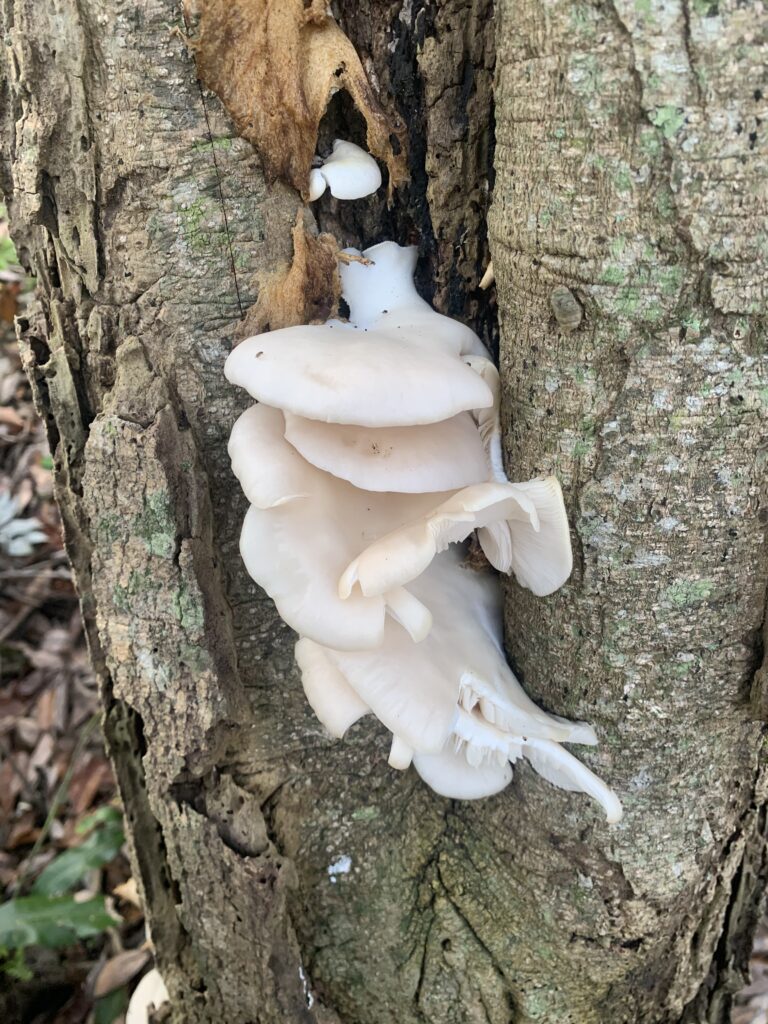
Oyster Mushroom in Central Florida. Photo by Green Deane
Cold snaps in Florida are an irritation, as are bouts of unseasonal rain. But they often encourage some plant to grow out of season, so keep an eye out. A couple of weeks ago we flirted with freezing temperatures, and now some oyster mushrooms (Pleurotus ostreatus) are enjoying a flush. They grow in tiers or clusters often on dead trees or stumps, especially after cold snaps. They are saprobe, which means they live off decaying organic matter, breaking down cellulose and lignin.ysters in the photo above have been growing on the same sweet bay trees (Magnolia virginiana) for many years. The stem is off to one side and gills are decurrent. Spore print is white or lilac. The white shell-like cap can grow light gray over time. Width up to six inches, stalk length to just over one inch. In warm weather we have another oyster species, Pleurotus florida, which interestingly I have found on palm stumps.
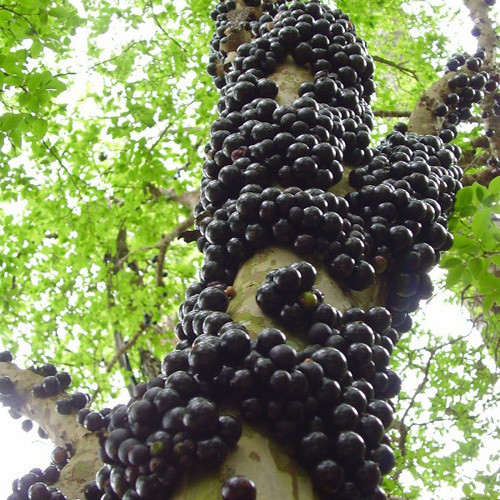
Jabuticaba fruit grows on the trunk and limbs of the tree. This one was in West Palm Beach near Dreher Park.
In its native Brazil the Jabuticaba is by far the most popular fruit. The Dutch knew about it in 1658. Jabuticaba made it to California by 1904. It’s a common ornamental and there are many cultivars” Sabara, Paulista, Rajada, Branca, Ponhema, Rujada, Roxa, Sao Paulo, Coroa, Murta, and Mineira. Per 100 grams Plinia cauliflora fruit has 45.7 calories, 0.11 grams of protein, 0.08 grams of fiber, 0.01 grams of fat and 12.58 gams of carbohydrates. Vitamin A is absent but it has 22.7 mg of vitamin C which is about a third of your daily need. The B vitamins are B1 (thiamin) 0.02 mg, B2 (riboflavin) 0;02 mg, and B3 (niacin) 0.21 mg. Two minerals are reported: Calcium 6.3 mg and phosphorus 9.2 mg. It is also called Myrciaria cauliflora. It’s a short tree planted in warm areas of North American and a common ornamental in Florida and the Gulf Coast. One is reported to sustain an 18F freeze and continued to thrive and fruit. Jabuticaba means “like turtle fat” referring to the fruit pulp, or, it means “tortoise place.” Take your pick. Myrciaria is from the Greek myrike (μυρίκη) which was the Greek name for the “tamarisk” a tree that is aromatic. In English it means Myrtle. Cauliflora means cauliflower-like. Plinia is Dead Latin for filled, full, rich, whole, perfect, well-equipped. You might remember from history Pliny the Elder and Younger.
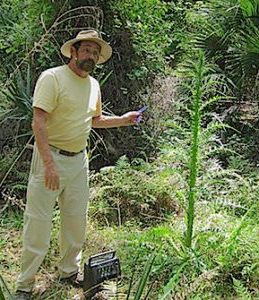
Foraging classes are held rain, shine, hot or cold. Photo by Nermina Krenata
Foraging classes: As the weather moderates classes are being regularly schedule.
Feb 8th, Eagle Park Lake,1800 Keene Road, Largo, FL 33771. Meet at the pavilion near the dog park. 9 a.m. to noon
Feb 9th, Bayshore Live Oak Park, Bayshore Drive. Port Charlotte, meet at Ganyard St. and Bayshore Lvd, 9 a.m. to noon
Bring cash on the day of class ($30 per adult) or click here to pay for your class. If cost is a hardship email me at: GreenDeane@gmail.com.
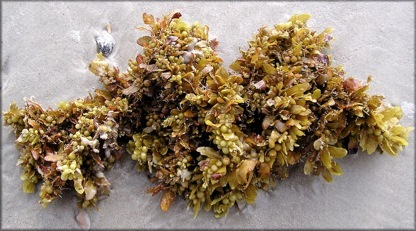
Sargassum: Edible but not the best of tastes and can sequester arsenic.
This time of year it is not unusual for our beaches to be deep in aging seaweed at the high-tide mark. It’s usually almost all one species, Sargassum edible but not the tastiest of sea vegetables. It is true that nearly all seaweeds are edible if harvested from clean water. When I lived in Japan an annual environmental demonstration was to develop photographic film from unaltered water taken from Tokyo Bay. Instead of taking a few minutes, the developing took several hours but the point was made: The bay water was polluted. Generally said there are only two non-edible seaweeds in North American waters. The first is Desmarestia ligulata. It is laced with sulfuric acid but is used to make pickles. You can find it along the northwest coast of the United States. You’ll know it when you find it because it will burn your mouth. The other in North America is a Cyanobacteria which is found in the Caribbean and linked to ciguarera poisoning. It’s not really a seaweed but is a blue-green algae found in the warmer waters. It is why one should never eat older barracuda. I should add never eat blue-green algae from fresh water either nor fish from a fresh water pond with a lot of blue-green algae. They are not on the menu. As for other parts of the world, there might be some toxic red seaweeds in the South Seas.

Sea Lettuce is perhaps the best of our local seaweeds.
Since most seaweed is edible, and nutritious, why isn’t it consumed more often? Taste and texture. I’ve collected Sargassum here in Florida and prepared it many ways. Semi-drying and frying isn’t too bad but Bladderwrack is better, Sea Lettuce better still. The latter makes very nice salads. Not surprisingly most land animals including birds don’t like seaweed. However, it does make good mulch and fertilizer. So while one may not use it directly in the diet it can still help sustain you with uses in the garden. During Victorian times it was highly used in English agriculture. Here are some of my articles on seaweed: Bladderwrack, Caulpera, Codium, Gracilaria, Sargassum, Sea Lettuce, and Tape Seagrass.

You get the USB, not the key.
All of Green Deane’s videos available for free on You Tube. They do have ads on them so every time you watch a Green Deane video I get a quarter of one cent. Four views, one cent. Not exactly a large money-maker but it helps pays for this newsletter. If you want to see the videos without ads and some in slightly better quality you can order the DVD set. It is nine DVDs with 15 videos on each for a total of 135 videos. Many people want their own copy of the videos or they have a slow service and its easier to order then to watch them on-line. The DVDs make a good gift for that forager you know especially on long, cold winter months. Individual DVDs can also be ordered or you can pick and choose. You can order them by clicking on the button on the top right hand side of this page (if your window is open wide enough.) Or you can go here.

Green Deane Forum
Want to identify a plant? Looking for a foraging reference? Do you have a UFO, an Unidentified Flowering Object you want identified? On the Green Deane Forum we chat about foraging all year. And it’s not just about warm-weather plants or just North American flora. Many nations around the world share common weeds so there’s a lot to talk about. There’s also more than weeds. The reference section has information for foraging around the world. There are also articles on food preservation, and forgotten skills from making bows to fermenting food. One special section is “From the Frightening Mail Bag” where we learn from people who eat first then ask questions later. You can join the forum by clicking on “forum” in the menu. 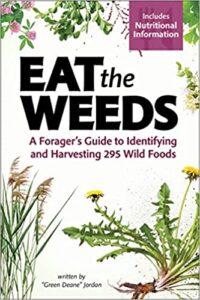
EAT THE WEEDS, the book, 274 plants, 367 pages, index, nutrition charts and color photos. It’s available in many locations including bookstores such as books a million, and Amazon. Most of the entries include a nutritional profile. It can also be ordered through AdventureKeen Publishing. This is weekly newsletter #624. If you want to subscribe to this free newsletter you can find the sign-up form in the menu at the top of the page.
To donate to the Green Deane Newsletter click here.


With 2 jaboticabas I was able to make up all my jam/preserves needed and some left over in 2004. Adding a tbsp lemon is an essential step